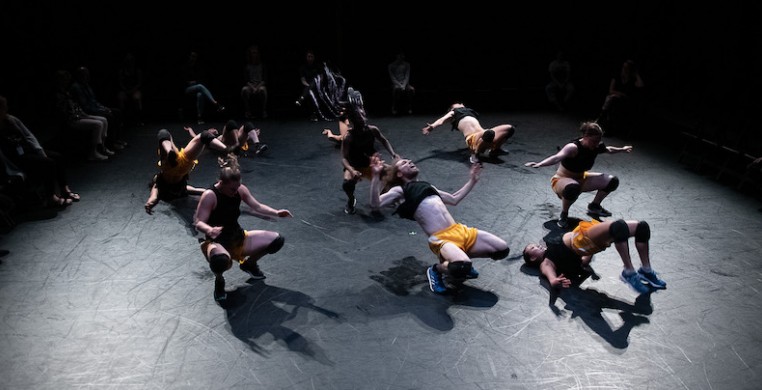“Congratulations, world.”
These two words, chanted by emcee Jyl Fehrenkamp at the bubbles of audience members sprawled across Daniel Webster Park’s welcoming lawn on Friday night, still sit in my mind. It was a phrase that so perfectly captured the emotions of the night and wrapped them in a pristine bow.
The citified greenspace offered dog-walkers and dance-lovers a space to come together and enjoy the chilly, spring evening. It was just dark enough to see the portable projector housed on the East end of the park while walking along the surrounding streets, which drew in more people than were aware of the event. The city felt alive at the tail end of the sunny day; an infectious energy circulated the audience of 40-something people as they settled in for the night’s festivities.
In collaboration with the Night Out in the Park performance series, the Dance Center of Columbia College Chicago celebrated graduating seniors’ accomplishment: successfully completing a rigorous undergraduate program amidst a pandemic. As images and videos from the last four years flashed across a bouncy house textured blow-up screen, giggles and claps erupted from a pile of pending graduates. The heartfelt goodbye, designed for seniors who experienced most of their final year from home, was both sweet and compelling. As an outsider looking in, I couldn’t directly relate to the sentimentality showcased by the dance department, but it took me back to my own college graduation just two years ago—the feelings were all right there. Congratulations to each of them as they embark on their next journeys, wherever and whatever they might be.
Thirty minutes into the night, the performance shifted focus from the graduates to New York City-based company, Abby Z and the New Utility. Founded in 2012 by choreographer Abby Zbikowski, the company is known for their high-intensity, physically demanding movement style. Streamed for Friday’s performance was “Abandoned Playground.” Initially premiered in 2017, the piece is clearly rooted in West African, hip-hop, tap, and post-modern dance styles, and pushes physical capabilities beyond anything I’ve had the pleasure of seeing before. The company was originally scheduled for their Chicago premiere at the Dance Center last spring, and as one of the first Dance Center COVID-19 performance cancellations, Zbikowski had to shift plans.
Though the film was recorded at Jacob’s Pillow in 2019, the theater in the round space set up on the screen was fresh and enticing—I simply felt like an extension of those in the audience at that time. The open and empty stage looked expansive next to the exposed lighting rigs and curtainless wings, which would have left the dancers visible but the downwardly tilted, birds-eye-view camera angle hid them from our line of sight. As the sneaker wearing, knee-pad clad artists entered the flat stage, I felt silly for assuming the work would be set on an actual playground rather than the metaphorical one to be built by the dancers on the Marley floor.
Throughout the 45-minute work, solo dancers, duets and trios moved on and off screen with ease—it wasn’t until the climax that I realized there were nine dancers in the piece. Not one limb, step or knee slide was out of place or off-time in exacting, jaw-dropping, unison choreography. With no music to score their movement, their breath cues—something typically cliche and overused, in my opinion—were both functional and ornamental. The choice of gym shoes made sense as the dancers fully embraced the sneaker squeak. If I closed my eyes, I would’ve mistaken the dance for a basketball game.
Zbikowski’s jarring start-stop choreography hypnotized me as the never-ending flow resembles Capoeira—a style of intense Brazilian martial arts. Highly acrobatic and unrelenting in physicality, the performers’ symphony of breaths grew in vigor as the finale of the piece came to a head. The nine dancers delivered striking, demanding knee-ography and effortful, repetitive jumps for a boundless amount of time— sympathetically, my lungs and knees hurt. The lack of overall context never felt problematic as the required physicality captivates on its own—eyes searching for the moment of reprieve.
Though we were unable to enjoy “Abandoned Playground” live and in person, the film adaptation successfully captured an intensity within the piece that embodied the feeling of being in the front row—further sparking an interest in Zbikowski and her choreographic style. As the evening came to a close and the audience trickled out, I was happy to have been a part of the celebration and farewell. The screen faded to black as everyone packed up their blankets and lawn chairs, and the echo of a siren in the distance reminded me I was still in the city. With the echo of “Congratulations, world” still ringing in my ears, and concern for the Abby Z and the New Utility dancers’ knees on my mind, I walked out of the park with a smile on my face and laughter surrounding me.

